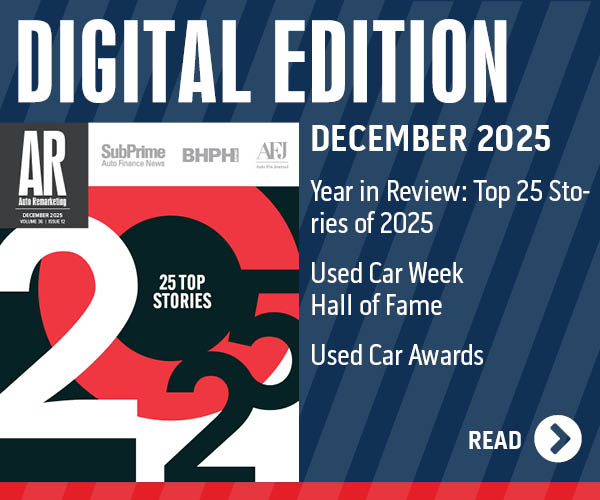Digital retailing, new-car affordability to keep the retail industry on its toes in 2020

By subscribing, you agree to receive communications from Auto Remarketing and our partners in accordance with our Privacy Policy. We may share your information with select partners and sponsors who may contact you about their products and services. You may unsubscribe at any time.
LAS VEGAS and DETROIT –
The expansion of digital retailing and how rising new-vehicle prices coupled with an ample supply of off-lease vehicles could tip the scale in favor of used-vehicles over new, are some major trends that will keep the retail industry on its toes in 2020.
That’s according to dealers and industry experts who attended Used Car Week, Nov. 11-15 in Las Vegas, and another reached by phone before the event.
Off-lease volume is still high
Cox Automotive senior economist Charlie Chesbrough, who did not attend the conference but spoke to Auto Remarketing ahead of the conference, said that off-lease volume peaked in 2019 at an estimated 4.1 million units and is expected to be flat to slightly down to 4 million in 2020. That’s up from about 2.2 million in 2014.
At the same time, new-vehicle prices have risen steadily, Chesbrough noted.
In 2012, 51% of all new vehicles had manufacturer suggested retail prices below $30,000, and 6% had MSPRs greater than $50,000, he said.
Compare that to 2019 when 28% of new vehicles had sticker prices below $30,000 and 24% had sticker prices greater than $50,000.
Subscribe to Auto Remarketing to stay informed and stay ahead.
By subscribing, you agree to receive communications from Auto Remarketing and our partners in accordance with our Privacy Policy. We may share your information with select partners and sponsors who may contact you about their products and services. You may unsubscribe at any time.
Though many consumers prefer more expensive SUVs over relatively less expensive passenger cars, the cost of many new SUVs are out of reach for many buyers, he said.
“That’s why we’re seeing such strength in the used side of the industry,” said Chesbrough, during an interview just prior to the conference. “Anyone who can’t afford a new vehicle can go to used, and there is much more to choose from in the used market now.”
Chesbrough said Cox Automotive estimated that the new-car industry would sell around 16.8 million units in 2019 and believes the market will decline to around 16.5 million in 2020.
What about fleet sales?
Another thing to watch this year are fleet sales to rental car and commercial fleet companies which were up “significantly” in 2019 for the second year in a row, while sales to individual retail customers were down, said Chesbrough.
The uptick in fleet sales is a direct response to tax reform laws that were passed in December 2017 which substantially increased the amount of depreciation that companies can claim on their taxes, making fleet purchases more advantageous, he said.
“The question going in to 2020 is, does that continue?” Chesbrough said. “Will we see fleet activity remain elevated or has that kind of run its course, and we start to see a pull back so fleet is down as well, matching what’s happening on the retail side,” he said.
Though a healthy demand for used vehicles has buoyed their prices, he cautions that if the economy wanes, “that excess supply” of used-vehicles could provide a real threat to new-vehicle sales and put a drag on used-vehicle prices.
Gravitating to used passenger cars
Ivan Drury, senior manager of insights, at Edmunds, also points out that some consumers are gravitating to used passenger cars because of those vehicles’ relatively low prices, a trend he expects will continue into 2020.
“Even electric vehicles, hybrids, the values are starting to change. Fiat 500e, $,6000, $7,000; Nissan Leafs — they were so cheap on the used market. “Now, they’re actually going up in value,” Drury said, following his conference presentation.
“For EVs it was lack of awareness; consumers didn’t know. But once you hear, ‘I can get this car for $7,000, and it’s only 2 or 3 years old,’ it really blew people’s minds. I even thought about buying one for fun.
“If you look at the sedans it was the same thing. It became such a compelling argument to pick up a used sedan that it was a no-brainer. You keep on lowering prices and nobody’s buying, then it’s ‘whoa, hold on — at that price point you got me’.”
From nice-to-have to necessity
Amit Chandarana is senior vice president, sales and business development at Roadster, an omnichannel commerce platform that licenses it digital retailing software to dealers. He said millennials, “a demographic that was literally born with a phone in their hands,” will make up 40% of the car-buying audience in 2020, and they want to purchase information upfront and without having to negotiate to get it.
He believes that demand for transparency from such a large part of the buying population will make it necessary for the industry to embrace digital retailing as an operational expense versus a marketing expense.
“We think that digital retailing is going to get to a point, it’s going to become operationalized, part of the DNA and the infrastructure of the dealership,” he said.
“The evidence is there; you could probably live an hour or two if your lights or power went down at your physical dealership. But you can’t live at all if your website goes down because all your traffic comes from there.
“This type of retailing is moving from a nice-to-have to a necessity for most retailers over the next couple of years.”
Outlasting 100 years
Also delving into digital in a big way is John Hairabedian, president, HGreg, based in St-Eustache, Quebec. The omni-channel, used-car group operates 31 dealerships, eight of which are in the U.S., and sells over 60,000 used vehicles annually.
Hairabedian said HGreg’s “internal mission is to create a company that will outlast 100 years” and its business strategy is to take a long-term approach on everything.
And “we don’t typically do quarter by quarter, but we do plans for five or 10 years down the line.”
That said, about 15% of HGreg’s sales are done online, and Hairabedian expects its online business and his retail operation in general to grow in 2020 and beyond.
“As the new generation of buyers come into the marketplace, they want to transact in a way similar to buying makeup or clothing or anything else on Amazon,” said Hairabedian. “We’re ready to offer a similar experience to them.”
HGreg was honored as the Tier 3 Auto Group of the Year at the conference’s Used Car Awards Luncheon.


